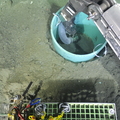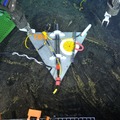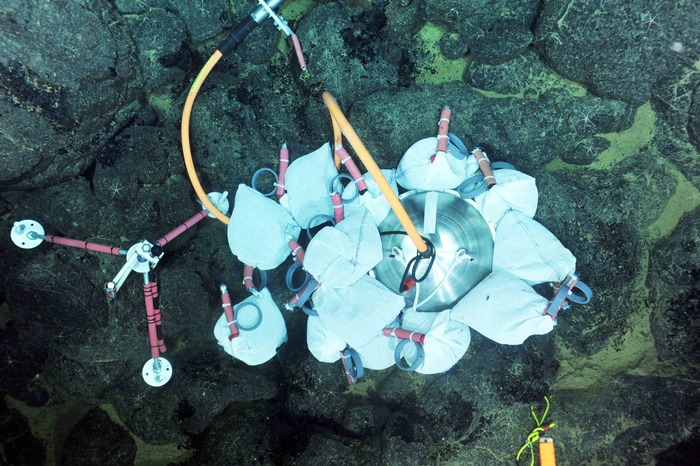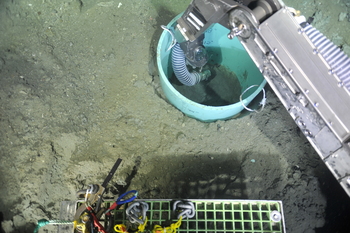
The ROV ROPOS vacuums out the sediment in a caisson at the summit of Southern Hydrate Ridge. In 2014, a broadband seismometer will be placed in the caisson and covered in silica beads to optimize aquisition of acoustic signals by lowering ocean "noise" (e.g. currents). Photo credit: NSF-OOI/UW/CSSF.
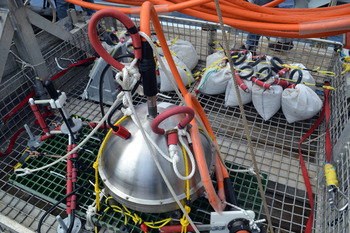
A low-frequency hydrophone (black tubular-shaped instrument in tripod with red legs), connected to a broadband seismometer, awaits installation by the Remotely Operated Vehicle ROPOS that will install this sensor in the International District 2 Site. Sand/gravel bags in the background will be piled over the broadband to dampen any noise by local currents. Photo credit: Mitch Elend, University of Washington, V14.
Broadband seismometers measure seismicity/earthquake activity along tectonic plate boundaries where two key phenomena can occur: large-magnitude subduction zone earthquakes and seismicity associated with migration of melt (magma) beneath the seafloor at underwater volcanoes. Historically, these instruments have been deployed by free-fall from the ship, which has commonly resulted in poor coupling to the seafloor, and, therefore, poor data quality.
Four of these instruments are now installed, one each at Slope Base (PN1A), at Southern Hydrate Ridge (PN1B), at the base of Axial Seamount (PN3A), and at the summit of Axial Seamount at the Eastern Caldera Site. The small array of broadband seismometers are installed to detect earthquakes along the subducation zone of the Oregon margin and at Axial Volcano.
In sedimented areas (Slope Base, Southern Hydrate Ridge, and at the base of Axial Seamount), the seismometers are buried beneath the seafloor sediments in caissons to obtain the highest quality resolution of seismic waves. At the summit of Axial Seamount, there is little sediment, and therefore the broadband seismometer was installed on basement rock, and surrounded by gavel-filled bags.
Because the seismometers are cabled and, hence, connected directly to shore, they will provide detection of earthquakes in real-time. Much larger arrays of cabled seismometers and pressure sensors are being utilized offshore in Japan to provide early warning dectection of seismic events such as the 9.0 magnitude megathrust Tohoku event and tsunamis (Dense OceanFloor Network System for Earthquakes and Tsunamis - DONET).
Instrument Specifics: The broadband seismometers are manufactured by Guralp, instrument model Guralp CMG-1T 360s-50Hz with CMG-5T Strong Motion, DM24/7-EAM Digitizer/Interface + Low Frequency Hydrophone (HTI-90-U). They have an Ethernet (10/100) interface, and are synced to pulse per second timing.
Sensors are in a Ti-housing and in sediment are buried in a 60 cm deep X 60 cm diameter caisson filled with silica beads, data are digitized.

